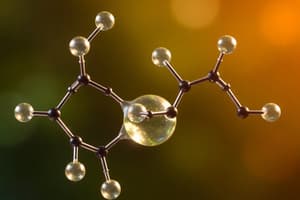Podcast
Questions and Answers
What is the typical absorption peak range for the C=O stretch in aldehydes?
What is the typical absorption peak range for the C=O stretch in aldehydes?
- 1715-1750 cm⁻¹
- 1735-1750 cm⁻¹
- 1720-1740 cm⁻¹ (correct)
- 1700-1725 cm⁻¹
Which statement about NMR characteristics of carbonyl compounds is accurate?
Which statement about NMR characteristics of carbonyl compounds is accurate?
- Amides typically have their N-H protons appearing downfield at 6-9 ppm. (correct)
- Ketones show shifts for neighboring protons between 9-10 ppm.
- Protons on aldehydes appear upfield in NMR at 6-9 ppm.
- The chemical shifts of protons on ketones are always above 10 ppm.
In mass spectrometry, what is a common fragmentation pattern for carbonyl compounds?
In mass spectrometry, what is a common fragmentation pattern for carbonyl compounds?
- Formation of dimeric structures
- Loss of small molecules like water (correct)
- Loss of a nitrogen molecule
- Retention of carbonyl group unchanged
Which type of reaction demonstrates the electrophilic nature of carbonyl groups?
Which type of reaction demonstrates the electrophilic nature of carbonyl groups?
Which carbonyl compound has a broad O-H stretch in its IR spectrum?
Which carbonyl compound has a broad O-H stretch in its IR spectrum?
Which carbonyl functional group typically shows a C=O stretch around 1640-1690 cm⁻¹ in IR spectroscopy?
Which carbonyl functional group typically shows a C=O stretch around 1640-1690 cm⁻¹ in IR spectroscopy?
What is a common application of carbonyl compounds in industry?
What is a common application of carbonyl compounds in industry?
Which of the following carbonyl compounds would experience a shift in C=O stretch due to steric hindrance?
Which of the following carbonyl compounds would experience a shift in C=O stretch due to steric hindrance?
Flashcards are hidden until you start studying
Study Notes
Spectrum or Record of the Spectrum - Carbonyl Chemistry
-
Introduction to Carbonyl Compounds
- Carbonyl compounds contain a carbon atom double-bonded to an oxygen atom (C=O).
- Common carbonyl functional groups include aldehydes, ketones, carboxylic acids, esters, and amides.
-
Infrared (IR) Spectroscopy
- Carbonyl functional group exhibits a characteristic strong absorption peak in the IR spectrum.
- Key IR Peaks:
- Aldehydes: C=O stretch around 1720-1740 cm⁻¹; C-H stretch around 2720-2820 cm⁻¹.
- Ketones: C=O stretch around 1715-1750 cm⁻¹ (shifts due to steric hindrance).
- Carboxylic acids: Broad O-H stretch around 2500-3300 cm⁻¹; C=O stretch around 1700-1725 cm⁻¹.
- Esters: C=O stretch around 1735-1750 cm⁻¹; C-O stretch around 1000-1300 cm⁻¹.
- Amides: C=O stretch around 1640-1690 cm⁻¹; N-H stretch around 3300-3500 cm⁻¹.
-
Nuclear Magnetic Resonance (NMR) Spectroscopy
- Carbonyl groups affect nearby hydrogen atoms’ chemical shifts.
- Key NMR Features:
- Aldehydes (H adjacent to C=O): typically appear downfield (9-10 ppm).
- Ketones: protons on neighboring carbon atoms display shifts in the range of 1-3 ppm.
- Amides: N-H protons appear downfield (6-9 ppm) due to deshielding by the carbonyl.
-
Mass Spectrometry
- Carbonyl compounds can fragment in mass spectrometry, providing information on their structure.
- Common fragmentation patterns include loss of small molecules (e.g., water for alcohol derivatives).
-
Reactivity and Mechanism
- Carbonyl groups are electrophilic, making them susceptible to nucleophilic attack.
- Common reactions include:
- Nucleophilic addition (e.g., with Grignard reagents).
- Reduction (e.g., to alcohols using LiAlH₄).
- Condensation reactions (e.g., with amines to form imines).
-
Applications
- Carbonyl compounds are crucial in organic synthesis and industrial applications.
- They serve as intermediates in pharmaceuticals, agrochemicals, and polymers.
-
Conclusion
- Understanding the spectral properties and reactivity of carbonyl compounds is essential for their identification and application in organic chemistry.
Introduction to Carbonyl Compounds
- Carbonyl compounds feature a carbon atom double-bonded to an oxygen atom (C=O).
- Common types include aldehydes, ketones, carboxylic acids, esters, and amides.
Infrared (IR) Spectroscopy
- Carbonyl groups show a distinct strong absorption peak in IR spectra.
- Key IR Peaks:
- Aldehydes: C=O stretch at 1720-1740 cm⁻¹; C-H stretch at 2720-2820 cm⁻¹.
- Ketones: C=O stretch from 1715-1750 cm⁻¹, with shifts due to steric hindrance.
- Carboxylic acids: Broad O-H stretch at 2500-3300 cm⁻¹; C=O stretch at 1700-1725 cm⁻¹.
- Esters: C=O stretch at 1735-1750 cm⁻¹; C-O stretch at 1000-1300 cm⁻¹.
- Amides: C=O stretch at 1640-1690 cm⁻¹; N-H stretch at 3300-3500 cm⁻¹.
Nuclear Magnetic Resonance (NMR) Spectroscopy
- Carbonyl groups influence the chemical shifts of adjacent hydrogen atoms.
- Key NMR Features:
- Aldehydes: H atoms adjacent to C=O appear downfield at 9-10 ppm.
- Ketones: Protons on neighboring carbons show shifts of 1-3 ppm.
- Amides: N-H protons appear downfield (6-9 ppm) due to deshielding effects.
Mass Spectrometry
- Carbonyl compounds can undergo fragmentation, revealing structural information.
- Common fragmentation includes the loss of small molecules, such as water in alcohol derivatives.
Reactivity and Mechanisms
- Carbonyl groups are electrophilic, making them prone to nucleophilic attack.
- Key reactions include:
- Nucleophilic addition (e.g., with Grignard reagents).
- Reduction to alcohols (e.g., using LiAlH₄).
- Condensation with amines to form imines.
Applications
- Carbonyl compounds are vital in organic synthesis and various industrial processes.
- They serve as intermediates in the production of pharmaceuticals, agrochemicals, and polymers.
Conclusion
- Knowledge of spectral characteristics and reactivity of carbonyl compounds is critical for their identification and application in organic chemistry.
Studying That Suits You
Use AI to generate personalized quizzes and flashcards to suit your learning preferences.




